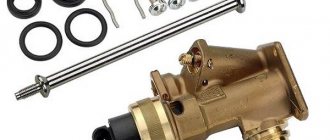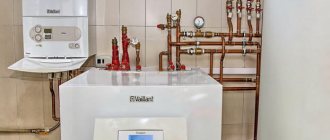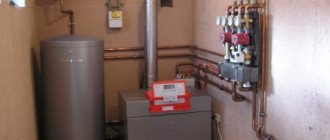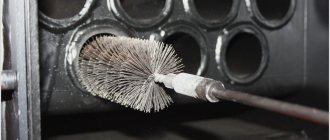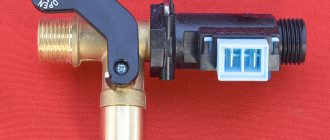Home / Gas boilers
Back
Published: 05/22/2019
Reading time: 2 min
10
32905
Gas boilers are designed to create comfortable living conditions. Double-circuit units provide the living space with heat and hot water at the tap. But it happens that a working boiler does not heat the water well and does not provide the necessary comfort.
The efficiency of the entire heating system depends on how the boiler operates. If there is a problem in the gas boiler itself, this can negatively affect the efficiency of the entire system and cause excessive consumption of energy resources. What happens when the boiler stops heating water? Let's look at the reasons and ways to solve this problem.
- 1 How does a boiler work?
- 2 The boiler does not heat water for heating
- 3 The boiler does not heat water for hot water supply
Operating principle
The manufacturer uses metal to make the Baxi combustion chamber. On the outside it is covered with a layer of heat insulation. Above it there is a heat exchanger, which is made of copper. When there is a change in temperature in the room, the thermostat turns on. Please note that the launch is carried out automatically. From it the signal to turn on is transmitted to the pump. The latter creates a vacuum in the return pipeline. After this, heated water begins to flow into the heating system line under a pressure not exceeding 0.45 bar.
The boiler starts at low power. It gradually increases until the temperature of the coolant increases to a given value. After this, the mode changes - from heating to modulation mode . When the coolant temperature decreases, a signal is received from the temperature sensor, which leads to the opening of the inlet valve. After this, ignition occurs, and then the water is heated again.
If already at the beginning of the boiler operation its power is quite high, then the burner is switched off automatically. After three minutes, you can restart the system.
If there is no need for heating the room, then the boiler is turned on in DHW mode. In this case, cold water enters the secondary circuit through a three-way valve, through which the heating line is closed. supplied to the burner through a gas valve , which leads to a gradual increase in boiler power. After heating the water, the temperature control mode is activated.
Types and causes of malfunctions
If the Baksi boiler has stopped working normally, then you can carry out repairs on your own, without turning to specialists for help. But troubleshooting can only be done if the damage is minor and easily fixable. If you have never encountered boiler repair, then in this case you should not take risks - contact a specialist straight away.
- the boiler burner does not turn on or goes out;
- it is impossible to light the boiler;
- when the boiler is operating, popping noises are heard in the combustion chamber;
- boiler overheating;
- max becomes insufficient. coolant heating temperature;
- when the equipment operates there is a lot of noise;
- One of the system sensors fails.
Causes of failure of Baksi boilers:
- moisture has entered the boiler;
- the quality of the coolant used is low;
- the gas pressure in the gas pipeline has decreased or a drop has occurred;
- there was a voltage drop in the electrical network;
- The installation of the heating system was carried out with errors.
Do-it-yourself Baxi boiler repair - Video tutorial
The boiler does not start
It is possible that during installation the phase and neutral are connected incorrectly or air has accumulated in the system.
Burner flame does not reach maximum power
The cause of the malfunction may be incorrect pressure setting in the heating system, a malfunction of the gas valve modulator, or a breakdown of the diode bridge.
Remedy: adjust the system parameters using the boiler operating instructions.
The boiler starts and immediately stops working
The reason is low gas pressure in the gas pipeline.
Remedy: reduce the incoming gas pressure to five mbar (standard - twenty-five mbar).
Weak heating of the coolant in the heating system
Remedy: check the pressure value on the gas valve; most likely, the min and max values have failed.
Modulation mode does not work
It is necessary to change the board, as well as the valve.
Temperature sensor readings become inaccurate
Replacing the sensor with a new one will help fix the problem.
Weak heating in the hot water supply system
The reason for this is the incomplete opening of the three-way valve or its breakdown. To confirm a valve malfunction, you should allow the system to cool, close the shut-off valves of the heating system, then turn on the boiler in hot water supply mode. If the valve is faulty, then heating in the heating system will occur simultaneously with the DHW.
When igniting a “popping” sound is heard in the boiler
This noise appears due to: insufficient gas combustion (minimum pressure adjustment is necessary); changes in the distance from the gas supply to the igniter during careless transportation of the Baxi boiler (the gap should be adjusted by setting it to 4-5 mm); excessive draft (use a damper to reduce the draft in the boiler).
How to adjust the gap between the burner and the igniter
Open the front panel and completely remove it from the boiler. Remove the damper from the inspection hole. Behind it is an igniter. To change the gap size, you need to unscrew the screw that secures the igniter electrode, then remove it and carefully bend the electrode. Then we install it in place and close the valve of the hole.
A sharp decrease in coolant temperature in the circuit
The reason for this is: clogged filters (they need to be cleaned or replaced); damage to pipes, radiators, their clogging or freezing (the malfunction must be identified and replaced or the defective section of the pipeline must be cleaned).
How to clean the primary heat exchanger with your own hands (video)
We drain the water by unscrewing the tap on the boiler on the right. If possible, drain the water from the heating system. For cleaning we use a device called Jelly. We connect the pipes of the device to the heating pipes of the baxi. Unscrew the cap on the device and fill in cleaning liquid. We turn on Zhel in the electrical network. Over the course of a couple of hours, use the knob on the device to switch the direction of the washing liquid “forward - backward”. After two hours, turn off the device and unscrew the tap to drain water from the baxi boiler. We remove the hoses, making sure that the washing liquid flows back into the device. We connect the boiler to the system and fill it with coolant. Cleaning the boiler will remove scale from its parts and prevent clogging and breakdowns.
Cleaning the secondary heat exchanger (heating circuit)
We use the washing device again. We connect it to the boiler and turn it on. The gas tap should be closed and the hot water tap should be opened. And after that, turn off the cleaning device. Thus, the liquid will be driven along a short circuit of the system.
Before installing the boiler, operating it or repairing it, be sure to consult a specialist. Despite all the positive qualities of baxi boilers, they, like all equipment, have their own margin of safety and service life. In this article, we looked at the main types of breakdowns, and also saw how to repair Baxi boilers with your own hands. We wish you and your boilers success.
Frequent malfunctions and measures to eliminate them
The burner flame does not reach its maximum power when the boiler is operating.
This gas boiler malfunction may occur due to incorrect pressure settings in the heating system. Also, such a breakdown can occur if the gas valve modulator is faulty. Another reason for its occurrence is the breakdown of the diode bridge.
Remedy: it is necessary to configure the system parameters using the boiler operating instructions.
The boiler starts but immediately stops working
This gas boiler malfunction may occur due to low pressure in the gas pipeline.
Remedy: it is necessary to adjust the gas pressure down to 5 mbar.
Weak heating of the coolant in the heating system
Remedy: Check the pressure at the gas valve. There is a high probability that there was a failure in the min and max values.
Modulation mode does not work
To eliminate the problem, the valve must be replaced.
Temperature sensor values become inaccurate
To resolve this problem, replace the old sensor with a new one.
Weak heating in the hot water supply system
The cause of this malfunction may be incomplete opening of the three-way valve. In some cases, its appearance is associated with a breakdown of such a valve. To accurately establish that the cause of the malfunction lies precisely in the valve , you need to wait some time until the system cools down. Then the shut-off valves of the heating system will need to be closed. When this is done, the boiler should be turned on to hot water supply mode. Confirmation of a valve malfunction will be heating in the heating system.
When the unit is ignited, “popping” noises are heard.
Noise can appear for several reasons:
- Insufficient gas pressure;
- Changed distance from the gas supply to the igniter due to careless transportation of the Baksi boiler.
To eliminate this malfunction, you should adjust the gap size. It should be set within 4–5 mm.
How to adjust the gap between the burner and the igniter
To make the correct adjustment on a Baxi gas boiler, you need to open the front panel and completely remove it from the boiler. After this, it is necessary to remove the damper from the inspection hole of the installation. Behind it you can find an igniter. To change the gap size, unscrew the screw that secures the ignition electrode to the boiler. Next, it is removed, and then carefully bent. Then you need to install it in its original place, and then close the damper.
Gas boiler Navien, main faults and their elimination
Do-it-yourself repairs require certain knowledge and skills in working with gas equipment. There is a special manual that describes the main fault codes. There are no repair instructions provided for users. The manufacturer assumes that troubleshooting will be carried out exclusively by service centers.
But many breakdowns can be fixed on your own without wasting time and money on a professional technician. To do this, it is enough to familiarize yourself with the main malfunctions and their elimination.
Navien gas boiler does not start
If the system does not turn on the control panel, then the problem is usually a lack of power from the electrical network. If the power supply is turned off by utilities, you should wait until the supply is restored. To understand how to turn on the equipment, just plug the cord into an outlet.
A common problem is the gas boiler turning on and off frequently. The source of the malfunction is an incorrectly installed circulation pump. The heating often turns off when the temperature range is incorrect. Also, the equipment turns on and off every 5-7 minutes in the absence of a thermostat.
The Navien boiler does not reach the set temperature
The most common malfunction of a Navien gas boiler is that the system does not heat up to the specified parameters. To fix the problem, you need to clean the heat exchanger using household plumbing chemicals or specialized compounds. To do this, the device is dismantled, the selected solution is poured into it, after which the part is thoroughly washed with a large amount of water. If the boiler does not heat hot water, then you can clean the heat exchanger of the DHW circuit in the same way.
The Navien boiler quickly gains and drops temperature
If the Navien gas boiler quickly heats up and cools down, then the fault should be sought in the heating system. You can adjust the pump speed to force fluid movement or remove air pockets.
We recommend: Gas heaters for tents - how to choose, review of the best models, prices and reviews, where to buy
During diagnostics, it is necessary to inspect the filtration system and the lumen of the heat exchanger. You may also need to replace the antifreeze. Spare parts for Navien gas boilers are freely available - they can be ordered online or purchased in a specialized store.
Malfunction of the boiler ventilation system
If you do not use Navien Deluxe floor or wall heating equipment for a long time, a lot of dust accumulates inside, which negatively affects the operation of the fan. To fix the problem, you will need to clean and lubricate the system.
Water oversaturated with oxygen
During natural circulation, water bubbles form, which burst and cause noisy operation of Navien Ice 24 and other models. If you add membranes to the system, the problem will disappear.
Pressure failures
Failures in water pressure of Navien heating devices are usually associated with leaks. The coolant penetrates into all small cracks, which affects the operation of the equipment. Also, the reasons include a malfunction of the three-way valve or secondary heat exchanger.
Errors and their codes
Error codes that may occur during the operation of Baksi gas boilers can be divided into two groups:
- complete blocking of equipment operation;
- switching the device to standby mode.
If the installation is completely blocked, you will need to restart the boiler manually. The blocking is activated if serious problems occur in the boiler operation, which can pose a serious danger to human health. Failures that cause the boiler to block include overheating of the equipment, and in addition, lack of draft. Blocking also occurs if there is no gas supply. The error resolves itself in rare cases. If this happens, the device starts in automatic mode.
Error E01
This error is the most common. When the flame control sensor is triggered, this code is displayed. Several reasons can lead to its appearance:
- no gas supply;
- there is no correspondence between phase and zero; this reason is relevant for phase-dependent models;
- no contact with flame sensor;
- the sensor is dirty or faulty;
- there are malfunctions in the ignition system;
- the gas valve is faulty or the electronic board is faulty;
- air access is insufficient for normal combustion;
- The gas pressure in the system is insufficient.
If this code appears on the display, then the first thing to do is check whether the sensor is connected correctly. It is also worth checking the gas supply. If everything is normal, then in this case you can press R. It should be held for 3 seconds.
If accidentally triggered, the equipment will continue to operate normally. If the error continues to appear, then in this case you should contact a specialist . Note that the occurrence of this error is associated with problems in the electronics. If you try to solve the problem on your own, then everything can end disastrously for gas equipment.
Error E10
Another common mistake is E10. The main reason for its occurrence is sensors that monitor the operation of pumps and monitor water circulation. This error may appear on the unit display in the following cases:
- the coolant pressure in the system has decreased;
- there is no contact between the board and the pressure switch;
- pressure switch is faulty;
- the pump operation sensor has become faulty;
- there are malfunctions in the pump;
- heat exchanger clogged.
If this error occurs, you should not try to fix it yourself. Self-repair is acceptable if the pump needs to be replaced. Carrying out this event will not be difficult. You can also clean the filters without assistance. All other work related to the repair of the Baksi boiler should be performed by an experienced specialist.
Errors E96, E97, E98
Urgent repairs by a qualified specialist are required if the gas boiler display shows errors E96, E97, E98. If they occur, it is unacceptable for the owner of the equipment to interfere with the operation of the boiler. The prohibition on intervention in the event of these errors is due to the fact that these three codes appear when the electronic board has become faulty.
Boiler doesn't heat water? There is only one reason - scale
Individual heating and hot water supply have long ceased to be something unusual. This is convenient and practical, and also allows you not to depend on the whims of utility services. Well, if some trouble suddenly happens, for example, it turns out that the boiler does not heat the water, then you will have to fix the breakdown on your own.
No, this does not mean that you should arm yourself with a tool and start repairing yourself - for this there are specialized companies that provide such services. If the heating boiler is working properly, but does not heat the water, then specialists will repair it, adjust the boiler according to your wishes, and, if necessary, flush the heating system. All work will be done efficiently and guaranteed.
Modern gas boilers are reliable and powerful heating devices that also perform the function of heating water. They successfully combine seemingly incompatible things - unsurpassed efficiency and compact size. But their uninterrupted operation is only possible with regular maintenance, detection and elimination of the slightest faults.
Malfunctions of heating boilers
Mostly, major malfunctions begin to appear during the heating season, when two boiler circuits are operating - heating and water heating. It may happen that it does not start at all, or does not heat well enough. With the launch, the issue will have to be resolved separately, but if the water does not heat up enough, then the reason may be a clogged heat exchanger. As you know, the water quality in our systems is far from ideal, and few users install mechanical cleaning filters in front of the boiler. This is where the heat exchanger becomes clogged, resulting in poor boiler performance.
Here are the most common malfunctions of gas boilers when they do not heat the water well:
- periodically switches off spontaneously,
- smokes a lot,
- does not develop enough power,
- makes noise
- clogged,
- the pump is broken.
If it happens that the gas boiler does not heat the water, then often the reason is the formation of limescale on the walls of the heat exchanger, which, as it accumulates, becomes very durable and not only reduces the water temperature, but also reduces the throughput of the boiler. The thermal conductivity of scale is tens of times less than that of metal, so it is not surprising that the boiler does not heat the water. If you do not take any preventive measures, then very soon you will have to completely disassemble the boiler and remove deposits mechanically.
This problem can only be helped by timely washing of the heat exchangers, and this should be done regularly, especially if there are no cleaning and softening filters installed in front of the boiler. Special chemicals are used for flushing, but they should be used with great care, since they are equally destructive to lime deposits and to the material from which the heat exchanger is made. It is best to invite a specialist for this purpose.
To ensure safe and efficient operation of your gas boiler, preventative maintenance is recommended. It is advisable to do this regularly before the start of the heating season; you should not wait for a situation when the boiler does not heat the water. This approach will ensure its long service life and economical operation. Major repairs are carried out as needed by a service center employee - it is strictly prohibited to do this yourself.
See also:
www.bwt.ru
If the boiler does not turn on when necessary
You open the mixer tap, but the boiler does not react and does not try to ignite the burner, and no errors occur. Regardless of the operation scheme of the boiler’s DHW circuit, a sensor is installed on the outlet pipeline, which detects that water collection has begun. It is also called a DHW flow sensor. Sensors come in different types: some simply detect the presence of water movement in the pipeline, others can quantitatively measure flow. The latter are used to provide greater comfort due to precise control of the burner power depending on the flow rate.
In both cases, when water flow begins, a signal must be sent from this sensor to the control board. If for some reason this does not happen, the boiler will be inactive.
The sensor type is most easily determined by the number of contacts. Two means it is a closing microswitch. Three – sensor with flow meter.
Sensor diagnostics
If the flow sensor is a microswitch, then for diagnostics it is enough to check the contact closure with a tester. To do this, disconnect the contacts from the sensor, connect the tester in “dialing” mode, and turn on the water tap. If a short circuit does not occur, it means that the sensor is faulty and requires inspection and, if necessary, replacement. It happens that accumulated dirt interferes with the circuit and it is enough to clean it. Poor quality of tap water and lack of pre-filters are the most common problem. Reed sensors contain a magnet, so they attract microparticles of rust and quickly fail.
Sensors with a flow meter record the amount of water flow, which can usually be displayed on the boiler display. For BAXI boilers you need:
hold the “i” button to access the information menu for 5 seconds
Use the DHW temperature adjustment buttons to scroll to parameter A08 (actual flow rate of water passing through the sensor, liters per minute * 10)
Now all that remains is to compare the actual water flow from the tap with the flow according to the sensor. If the actual flow rate does not correspond to the sensor value, then most likely it needs to be replaced.
Since the mechanical part of the flow sensor is a turbine, if it gets dirty, it can jam and the signal from the sensor disappears. There is no signal from the flow sensor - the boiler stops heating water.
Three-way valve
A three-way valve is installed in boilers with two heat exchangers. When a signal is received from the flow sensor, the electronics gives a signal to the valve and the heated water from the first heat exchanger is sent to the second heat exchanger, where the heat is transferred to the passing tap water. If, for example, no actual switching occurs (the valve is faulty), then the coolant will continue to circulate in the heating circuit and no heat transfer to the hot water circuit will occur.
If, for example, a valve only partially closes the heating circuit due to a malfunction, then there will be problems with insufficient heating of hot water, since part of the heat will go to the heating system.
The main problems are why the boiler does not heat water
More often, boiler problems are detected during the heating season, when both circuits of the device are operating. There are two main problems that owners of wall-mounted gas boilers such as Ariston face:
- all boiler systems are working, the device turns on, but heats the water poorly or does not heat at all;
- the boiler does not start and, as a result, no hot water is supplied.
Each of these problems has its own causes and solutions. To troubleshoot problems, you need to figure out what caused them and what caused them.
Before finding out the reasons for the malfunction of the unit, you should look at the operating manual, read the instructions and check that the settings and connections of the device are correct.
Note! Modern gas boilers are equipped with a diagnostic system that detects faults and displays an error code on the display. The instructions for the unit will help you decipher the codes.
If all requirements and conditions are met, the most common causes of malfunctions should be considered:
- Blockage. Experts say that using unfiltered working fluid increases the risk of clogging the heat exchanger pipes. The resulting scale reduces its thermal conductivity, which causes the unit to operate with excessive energy consumption. In this case, the optimal temperature regime is not achieved even with continuous operation of the device. Due to limescale deposited inside the heat exchanger pipes, the metal is subject to corrosive changes, which can lead to its rupture.
- Faulty pump. The circulation of the coolant may be stopped due to the accumulation of air, the so-called air lock in the pump. The second cause of a pump malfunction may be a rotor that is jammed. A circulation pump that stops functioning can lead to overheating of the gas boiler.
- The flow sensor is stuck. Inside the boiler there is a sensor in the form of a turbine, resembling a small fan. When the turbine rotates inside the sensor, an electrical pulse is generated due to the fluid flow, which is supplied to the control unit. This way the electrical system understands that it needs to warm up the coolant.
- The three-way valve is stuck. Such a malfunction will not allow you to switch the water supply from heating to DHW. Valve stoppage can occur due to blockage, either in the part itself or in the gas hose or filter.
- Insufficient pressure. If the volume of liquid in the system does not create the required pressure, the water supply valve does not open, which leads to burner ignition failure.
Modulation errors on the burner
To heat running water, in most cases a boiler power close to maximum is required. In modern boilers, the burner power is regulated over a wide range. The adjustment occurs by changing the amount of gas supplied by the gas valve. The amount of adjustment is determined by the control board depending on the operating logic and settings. The process can be observed visually by the height of the flames on the burner.
If the boiler settings are set to 100% boiler power in DHW mode, but visually the flames on the burner are weak, or obvious interruptions are visible, then you should check:
setting the gas valve (static and dynamic gas pressure)
Such checks should only be performed by a qualified person.
Malfunctions of heating boilers
A dirty heat exchanger is a common reason for the lack of hot water in the DHW circuit.
Common boiler breakdowns include:
- coolant leak;
- water hammer;
- after turning on the burner, the lock is activated;
- the burner does not turn on;
- fuel burns unevenly, in waves;
- soot is formed;
- decreased productivity;
- During operation of the burner, the ignition is switched on;
- soot forms on the walls of the chimney and combustion chamber.
To resolve a problem, you must first determine the cause of the problem.
Built-in pump malfunction
The reason for the lack of hot water may be a clogged built-in pump.
An important part in the heating system is the circulation pump. The quality of heating and the functioning of hot water supply depend on its uninterrupted operation. There are several signs and causes of breakdowns:
- The unit makes uncharacteristic sounds. This occurs due to oxidation of the shaft, the entry of a foreign object into the structure, problems with the power supply, air in the pipes, dry running of the mechanism, and the appearance of cavitation.
- After turning on the boiler, the pump does not start. Perhaps there is no power supply, the fuse has tripped.
- After a short period of time after switching on, the structure switches off: limescale deposits in the stator shell.
- Hot water does not turn on in a double-circuit boiler.
Also, the reasons for poor operation of the circulation pump are poor pressure in the system, wear of the bearing, which causes additional vibrations in the line, and low pressure.
To troubleshoot problems, you need to check the presence of electricity, clean the pipes and other elements, replace failed parts, and remove foreign objects from the system.
The heat exchanger is clogged
You can clean the heat exchanger from scale using a solution of citric acid and an electric charge.
Heated gases are transported through channels, which are collectively called a heat exchanger. The design features are that the walls of the artery simultaneously serve as partitions of the water circuit, along which the coolant constantly moves, heating the metal surface. The combustion process is associated with the intense release of flue gases, partly consisting of soot and tar, which create a deposit inside the boiler, on the chimney. Therefore, the manufacturer recommends regularly cleaning the equipment at least once every 30 days and during the preparation of the device for the heating season.
We recommend: How to install a stove in a country house
When soot settles on surfaces, the performance of the mechanism decreases, fuel consumption increases, and the risk of costly breakdowns and internal fire in the contaminated area increases.
Chemical cleaning of bithermal heat exchanger
Washing is carried out without dismantling the heat exchanger; to perform the procedure, you will need a booster with a volume of 20-30 liters. Before starting work, it is necessary to drain the coolant from the heating system using a Mayevsky tap.
Fill the booster reservoir with the flushing solution, and lower the hoses into the container, the free ends of which are connected to the heat exchanger pipes. Liquid movement is possible only under the action of a circulation pump; it must be connected to one of the hoses.
The ends of the hoses must be put on the heat exchanger pipes, and the free ends must be placed in a booster with flushing liquid, connecting the circulation pump. Work can be performed without removing the heat exchanger
It would be ideal to connect a reversible pump with the ability to change the direction of fluid flow. All that remains is to start the boiler for heating at a set temperature of 50-60 degrees and leave for 15 minutes, periodically changing the direction of circulation.
Chemical cleaning of the secondary heat exchanger
Flushing the secondary heat exchanger of a double-circuit gas boiler can be performed in a similar way to flushing a bithermic heat exchanger. However, you need to take into account that the secondary heat exchanger is easily removed, so you can improve the quality of cleaning by dismantling it.
To gain access to the heat exchanger, it is necessary to dismantle the front panel of the unit and move the control unit to the side. The heat exchanger is secured with two bolts at the bottom, which can be easily removed by unscrewing them.
It is most effective to place the heat exchanger removed from its original location for washing in a container with a salt-dissolving solution and boil it. Instead of a suitable household product, you can use a 20% citric acid solution.
Good results can be achieved by boiling the secondary heat exchanger in a washing solution
When cleaning any heat exchanger, the final stage is rinsing with clean water. This measure is necessary to remove traces of a chemically aggressive substance and stop its effect on the walls of the heat exchanger.
There is another way to clean the heat exchanger - hydrodynamic. Its implementation requires special equipment and pressure control at each stage of cleaning. Therefore, without special knowledge and skills, doing it yourself can be dangerous.
Regular cleaning of the heat exchanger will avoid the need to use very aggressive compounds and will make it possible to extend its service life. It is recommended to clean the heat exchanger annually at the end of the heating season.
Problems with the heating circuit
The pump must be selected according to the requirements of the heating circuit.
Malfunctions in the operating mode of the heating circuit are not always associated with a malfunction of the main heating element. If the boiler works, but does not heat the batteries, the reason must be sought in the wiring itself.
List of main heating circuit malfunctions:
- the filter on the return line or the needle tap (Maevsky tap) is clogged;
- insufficient power of the circulation pump;
- the rules for installing a heating circuit with natural circulation have not been followed.
Any of the above problems must be resolved before the start of the heating season. Otherwise, the room may be left without heat for several days, since the repair involves completely draining the coolant.
So, why doesn’t the boiler heat the batteries if everything worked fine over the previous years? The reason is a dirt plug that has formed on the heating circuit filter and completely blocks the coolant flow. It can be solved simply - the water is drained from the pipes or its circulation is blocked using bypasses, and the filter is cleaned. To prevent a recurrence of such a situation, it is necessary to completely replace the coolant with parallel flushing of the entire circuit.
In a gravity system, the slope of the pipes is key.
The second reason why the boiler works but the radiators are cold is the insufficient power of the circulation pump. The performance of the device is not enough to pump the entire volume of coolant in a timely and efficient manner. Or the heating system in the house has branches that are located at a significant distance from the pump. As a result, the circulation pump overheats, the heating equipment operates with excessive energy consumption, and the radiators remain cold. The solution is to change the coolant pumping device to a more powerful one.
If the house has a two-pipe heating circuit with natural circulation of water, and during the heating season it is often noticed that the boiler is on and the radiators are cold, then the reason lies in non-compliance with the slope of the main line. According to regulatory documentation, only a pipe slope of 10 mm per linear meter in a heating system with natural circulation will ensure normal coolant movement. The result is uniform heating of the batteries throughout the house. If there is no slope, the coolant stagnates, which negatively affects the temperature of the radiators. The problem can be solved by completely redoing the wiring.
Modulation errors on the burner
To heat running water, in most cases a boiler power close to maximum is required. In modern boilers, the burner power is regulated over a wide range. The adjustment occurs by changing the amount of gas supplied by the gas valve. The amount of adjustment is determined by the control board depending on the operating logic and settings. The process can be observed visually by the height of the flames on the burner.
If the boiler settings are set to 100% boiler power in DHW mode, but visually the flames on the burner are weak, or obvious interruptions are visible, then you should check:
- setting the gas valve (static and dynamic gas pressure)
- control board
Such checks should only be performed by a qualified person.
Three-way valve
A three-way valve is installed in boilers with two heat exchangers. When a signal is received from the flow sensor, the electronics gives a signal to the valve and the heated water from the first heat exchanger is sent to the second heat exchanger, where the heat is transferred to the passing tap water. If, for example, no actual switching occurs (the valve is faulty), then the coolant will continue to circulate in the heating circuit and no heat transfer to the hot water circuit will occur.
If, for example, a valve only partially closes the heating circuit due to a malfunction, then there will be problems with insufficient heating of hot water, since part of the heat will go to the heating system.
We recommend: How to make a bio-fireplace with your own hands: assembly instructions
Problems with the flow sensor
A possible reason why a gas boiler may stop heating water is a problem with the flow sensor. The device is a small fan that rotates under the influence of water flow. As a result of rotation, a signal is sent to the control board to heat the water. Due to clogging, the fan may stop rotating.
You can clear the blockage without dismantling the device. To clean it, just open and close the water supply tap several times. If such actions do not give the desired result, you will have to remove the sensor and clean it.
To do this you need:
- Disconnect the gas boiler from the electrical network;
- Turn off the water supply tap;
- Drain the water from the unit.
Typically, the flow sensor is secured with a bracket, by removing which you can easily remove the device. The assembly is removed completely; to remove the inner part, you need to turn the parts in the groove. During disassembly, you should clean the filter mesh and remove the turbine.
Often, turbine blades are covered with a layer of rust that needs to be thoroughly cleaned. If you remove the three clamps, you can remove the turbine itself to clean the internal plane of its landing. Now all that remains is to reassemble in reverse order.
When disassembling the flow sensor, you need to clean the filter and turbine blades
If cleaning the flow sensor does not bring the desired result and there is no hot water, you will have to replace the entire assembly.
Temperature sensor malfunction
The boiler determines the actual hot water temperature based on the readings of the temperature sensor. Therefore, if for some reason it receives incorrect readings, the boiler may not operate correctly in the hot water preparation mode. The temperature sensor is a thermistor with resistance depending on temperature. Testing such a sensor consists of measuring its resistance at a known temperature. Baxi boilers are equipped with NTC sensors with an inverse dependence of resistance on temperature. At room temperature, the sensor resistance should be approximately 10 kOhm, at a temperature of 45 degrees 4.3 kOhm.
Heat exchanger clogged (reduced throughput)
Often the fouling of the internal walls of the heat exchanger with scale or mud deposits is the cause of problems with hot water. If tap water does not undergo pre-filtration (rough cleaning) and the temperature of the hot water is too high, the walls of the heat exchanger become overgrown with scale and dirt over time, reducing their thermal conductivity and flow area. Each time the user increases the DHW temperature on the boiler more and more in order to obtain the desired result on the mixer. As the temperature rises, scale forms even faster and, as a result, the temperature of the boiler's hot water supply is at its maximum, and the water does not heat up enough. This process has a particularly negative effect on a boiler with a bithermic heat exchanger. Plate heat exchangers are easy to clean.
Control board errors
The control board should be considered as the cause of hot water problems when all other checks have failed. The cause may be a malfunction in the flame modulation circuit. The boiler control unit constantly adjusts the burner power depending on the conditions, and if there is a fault on the board, the boiler can spontaneously reboot or turn off when it reaches maximum power, which in most cases is required precisely in the hot water preparation mode.
It is also possible that boards may be configured incorrectly as errors. But this only applies to those cases where problems appeared after its replacement. BAXI boards are universal and require customization for a specific boiler.
Gas boilers are designed to create comfortable living conditions. Double-circuit units provide the living space with heat and hot water at the tap. But it happens that a working boiler does not heat the water well and does not provide the necessary comfort.
How does a boiler work?
To understand the situation more clearly, you need to understand the principle of operation of the boiler. Double-circuit gas wall-mounted boilers such as Baksi or Ariston consist of several components. In the gas part, the incoming fuel is burned, the water part ensures the supply of heated water from the heat exchangers to the heating system, and the smoke removal part is responsible for removing combustion products outside the home.
Depending on the user settings, temperature sensors adjust the water heating mode. A sensor on the return pipeline turns off the boiler, depending on the achievement of the required temperature set for the return. However, the system pump does not stop running until the heat exchanger temperature drops.
This is provided to prevent the water from boiling in it. As soon as the coolant cools down to the maximum level, the electronics will send a signal to turn on water pumping and the gas valve. The whole process will start again. When you open the tap in the mixer in a double-circuit boiler, a flow sensor reacts, which informs the electronics about the need to switch the three-way valve to the mode of heating water for DHW.
When the hot water tap is turned off, it returns to heating mode. Some manufacturers provide heating for both heat exchangers during periodic switching.
The boiler is working but the radiators are cold
Cats don't sleep on cold radiators.
The efficiency of the entire heating system directly depends on the performance of the boiler. Malfunctions of the main heating equipment negatively affect the efficiency of the home heating circuit and lead to excessive energy consumption. That is why any breakdowns, even the most insignificant ones, are given special attention. People’s experiences are understandable if the boiler is working and the radiators are cold. After all, this not only reduces the level of comfort in the house, but also entails expensive repairs. To properly solve a problem, you need to understand its essence. Only a specialist can correctly determine the reasons why the boiler does not heat the batteries. Also read: “Why do radiators heat poorly?“.
Boiler malfunctions
Typical problems with the operation of heating equipment:
- malfunction of the built-in pump;
- the heat exchanger is clogged;
- The three-way valve does not work.
If the boiler is working and the radiators are cold, experts recommend, first of all, assessing the technical condition of the main heating element. More specifically, determine whether the circulation pump built into the device is working. This part is an invariable attribute of modern equipment and is designed to increase the efficiency of its operation. Very often, after a long period of inactivity in the summer, the pump can become clogged or become covered with a layer of limescale. As a result, it does not remove the heated coolant from the heat exchanger in a timely manner. The boiler is boiling, but the radiators are cold.
It is strictly prohibited to independently repair such complex equipment as a boiler. In this case, either a specialist from the service center or a repairman with the appropriate certificate or permit is called to your home.
Experts do not recommend using ordinary tap water as a coolant, as it is hard. When the coolant temperature increases, dissolved salts settle on the heat exchanger. As a result, the following problem arises: the boiler is working, but the radiators are barely warm. Scale reduces the thermal conductivity of the heat exchanger, so the water in the circuit does not heat up, although the heating element constantly works with excessive energy consumption. You can fix the problem by changing the coolant and cleaning the heat exchanger. This video will help you understand how to clean the heat exchanger correctly:
A double-circuit boiler heats water, but does not heat the radiators. Here you need to pay attention to the serviceability of the three-way electric valve. It is responsible for switching the bypass from heating circuit maintenance mode to DHW and CO mode.
Before making a heating register with your own hands, familiarize yourself with the technical base.
Why can't antifreeze be used for radiators? The answer is here.
Problems with the heating circuit
The pump must be selected according to the requirements of the heating circuit.
Malfunctions in the operating mode of the heating circuit are not always associated with a malfunction of the main heating element. If the boiler works, but does not heat the batteries, the reason must be sought in the wiring itself.
List of main heating circuit malfunctions:
- the filter on the return line or the needle tap (Maevsky tap) is clogged;
- insufficient power of the circulation pump;
- the rules for installing a heating circuit with natural circulation have not been followed.
Any of the above problems must be resolved before the start of the heating season. Otherwise, the room may be left without heat for several days, since the repair involves completely draining the coolant.
So, why doesn’t the boiler heat the batteries if everything worked fine over the previous years? The reason is a dirt plug that has formed on the heating circuit filter and completely blocks the coolant flow. It can be solved simply - the water is drained from the pipes or its circulation is blocked using bypasses, and the filter is cleaned. To prevent a recurrence of such a situation, it is necessary to completely replace the coolant with parallel flushing of the entire circuit.
In a gravity system, the slope of the pipes is key.
The second reason why the boiler works but the radiators are cold is the insufficient power of the circulation pump. The performance of the device is not enough to pump the entire volume of coolant in a timely and efficient manner. Or the heating system in the house has branches that are located at a significant distance from the pump. As a result, the circulation pump overheats, the heating equipment operates with excessive energy consumption, and the radiators remain cold. The solution is to change the coolant pumping device to a more powerful one.
If the house has a two-pipe heating circuit with natural circulation of water, and during the heating season it is often noticed that the boiler is on and the radiators are cold, then the reason lies in non-compliance with the slope of the main line. According to regulatory documentation, only a pipe slope of 10 mm per linear meter in a heating system with natural circulation will ensure normal coolant movement. The result is uniform heating of the batteries throughout the house. If there is no slope, the coolant stagnates, which negatively affects the temperature of the radiators. The problem can be solved by completely redoing the wiring.
Is it possible to heat a garage using antifreeze for cars?
Which liquid to clean heating systems should you choose? The selection criteria are described here.
Why are the radiators cold when the boiler is running?
Low efficiency of the heating system can be the result of malfunctions of both the circuit itself and the main heating element. In the case of a heating device, it is necessary to pay attention to the three-way valve, the functionality of the pump and the technical condition of the heat exchanger. Typical problems for heating wiring are a clogged filter, insufficient power of the circulation pump and lack of slope of the pipes of the circuit with natural water circulation.
utepleniedoma.com
The boiler does not heat water for heating
So, let's look at the main reasons why a gas boiler does not heat water for the heating system and what to do about it:
- airlock. It is necessary to inspect the heating system for the presence of air in the radiators. To eliminate this problem, you need to install an air vent. Its operating principle is similar to that of an expansion tank, but it is capable of maintaining pressure in the system. Using an air vent, you need to bleed air from the system. It is important to inspect the valve itself for mechanical blockages - scale may be present there;
- corrosion in radiators. Clogging of heating devices can be determined by draining water from the system. If the water flows dirty, then you need to flush the system until visually clean water appears;
- connection errors. Hot water may not flow if the diameter of the pipes is not as specified in the project or instructions. It is necessary to check the compliance of the pipeline, the correct connection and the quality of installation of shut-off valves;
- insufficient pressure in the network. You should try adding water to the heating system, as there may not be enough pressure to trigger the automatic ignition of the burner;
- presence of scale in the heat exchanger. The first sign is prolonged heating of the coolant and heating of the batteries. It is necessary to get rid of sediments and carry out boiler water treatment. To do this, you need to disassemble the boiler and remove the heat exchanger assembly.
Before doing this, you need to shut off the flow of gas and water to the device. Then flexible connectors from the pump are connected to the heat exchanger and it is washed with a composition containing a special cleaning agent, which can be purchased over the counter. After which the parts are washed with water.
Some manufacturers allow the use of antifreeze instead of water in the heating system. This substance can be used in the following boilers: “Baxi”, “Vaillant”, “Proterm”, “Beretta”, “Korea Star”. However, it should be understood that each manufacturer recommends using its own antifreeze;
- filter clogging. If the filter screens are clogged with mechanical debris, the radiators may also have poor heating. Therefore, the filter should be checked and cleaned regularly by rinsing with water. If clogging occurs too often, then such a part must be replaced;
- incorrect setting. First of all, if there is weak or no heating, you need to check the settings of the control unit. The temperature may be set insufficiently and the gas does not heat the water;
- malfunctions of pumping equipment. If the pump power is not enough to ensure good circulation, it may turn off if it overheats. This can happen when the DHW circuit is turned on;
- incorrectly selected heating devices. If the system has radiators with unsuitable heat transfer and design parameters, this can also lead to low heating;
- incorrect slope of pipelines. Most often this problem occurs in systems with natural circulation. Regulatory documentation specifies that the slope of pipes should be 10 mm per meter of pipe. If these requirements are not met, circulation may be disrupted and, as a result, there may be no heating due to low coolant flow.
Troubleshooting: why does a gas boiler not heat hot water well?
If a gas boiler does not heat hot water well due to a clogged or ruptured tube in the heat exchanger, repairs are necessary. It is performed by replacing a failed unit. In this case, threaded connections are not used, so disassembling and subsequent installation yourself will be difficult. To create a high-quality connection by soldering, it is better to invite an experienced craftsman. A qualified specialist will ensure the required level of quality and provide written guarantees.
Finding out about the problem in advance is not easy. The scale layer grows slowly, so it will not be possible to register a clear decrease in power. Extraneous noise can be caused by the passage of sand and other mechanical impurities through the pipes. Technological openings are too small for visual inspection. To complete this, dismantling is required.
The information provided explains why emergencies of this type occur unexpectedly. To prevent them from developing into a more complex problem, you can equip your boiler equipment with a modern remote monitoring system. Some manufacturers offer ready-made solutions in the form of an additional electronic unit and specialized software.
The corresponding application is downloaded to the smartphone. The advantage is the ability to remotely change settings and check temperature sensor readings. If the Navien gas boiler does not heat hot water due to scale, replacing the heat exchanger is not enough. These same contaminants reduce the internal diameter of pipes and narrow the ducts in radiators. A complete cleaning of the system is necessary.
This procedure is performed according to the following method:
- Pour the water into the drain.
- Rinse all circuits sequentially or simultaneously with a special solution.
- It is also used to clean the heat exchanger if it is only clogged and can be used further.
- After assembly, the functionality of the system is checked under pressure.
- Eliminate identified defects (cracks, loose connections).
To remove calcium solutions, magnetic water converters mws or aggressive chemical compounds are used. The duration of the standard procedure for one household object is several hours. Appropriate corrections are made taking into account the actual state of the system. Strong acids can damage metal parts and solder joints of an Ariston double-circuit boiler. For this reason, experienced teams take repair tools to complete orders.
It is possible to carry out such procedures independently. But for many ordinary users it is not advisable for several reasons:
- You have to purchase expensive equipment for pumping liquids that will be used.
- Independent selection of the optimal composition of the solution will cause difficulties.
- During this procedure, there are no mechanisms for operational control of processes within the pipeline system. This increases the likelihood of breakdowns.
- When performing transactions in person, you will not receive official guarantees from a third party. Any problems that arise in the future will have to be resolved at your own expense.
Additionally, it should be noted that careless handling of aggressive chemical compounds can cause harm to health.
Preventive actions
Specialists from companies offering flushing recommend doing this every heating season. It is combined with a general inspection of the equipment. The frequency is adjusted taking into account the level of rigidity, the intensity of operation of Baxi gas double-circuit boilers, and other significant factors.
Tips like this are really helpful. Regular cleaning will prevent more complex procedures. Simultaneous testing will help identify problems at an early stage. However, it is necessary to emphasize the main disadvantage of this technology - it itself can damage the equipment. It is especially unpleasant if defects appear during the heating season. It will be quite difficult to prove the guilt of the workers who did the cleaning.
Instead of using potentially dangerous techniques, effective protective measures are used. They are based on modern water treatment technologies.
To prevent scale from forming in a Navien or Ariston heating boiler, install a water filter to prevent scale from forming in front of it. They dissolve when a stream of water passes, creating dense shells around microscopic scale particles (in the first stages of growth). After such a “modification”, harmful impurities are not able to attach to the walls and to each other. They pass freely along the circuit and are removed into the sewer system.
The second method is to replace harmful compounds with sodium ions. This procedure is carried out using special resins. They are poured into two large containers, which work alternately. As contaminants accumulate, washing is performed using an inexpensive regeneration solution made from table salt. Such equipment is used for general protection of apartments, cottages, and other real estate objects.
The next reason why a gas boiler does not heat hot water and its solution is a protective technology that appeared recently, although it has been known for more than a hundred years. The fact is that previously only permanent magnets were used for descaling treatment. They lose their beneficial properties over time. Moreover, a “habituation” effect was experimentally discovered when calcium and sodium compounds stop responding to the corresponding influences.
Nowadays the technique has been improved! Today, electromagnetic converters with high-frequency oscillation generators are used. With minimal energy consumption (5-20 W per hour), they operate at a distance of up to 2 km along the length of the pipeline from the installation site of the Baxi or Proterm heating boiler. This technique maintains its initial efficiency throughout its entire service life.
Ultrasound can grind scale particles and remove old formations. But this technology is rarely used. Like acids, it can destroy the structural components of the water supply system. It should also be noted the likelihood of harmonic vibrations occurring in the audio range.
Membrane technologies provide a high level of purification from various impurities, including hardness salts. But standard household installations process no more than 200 liters. liquids per day. This is not enough for the needs of the Vailant heating boiler and hot water supply.
Features of different boiler cleaning technologies and conclusions
If a gas boiler stops heating water, it has to be repaired. To extend the life of the Buderus or Ferroli heating boiler and prevent accidents, various techniques are used. To choose the appropriate option, you need to pay attention to the following details:
- Flushing with aggressive chemical compounds does not eliminate the problem, but eliminates scale that has already formed.
- Polyphosphates pollute water, so this protection is used only for the heating circuit.
- Sodium compounds are harmless (this is ordinary, well-refined table salt). However, after appropriate treatment, the water will acquire a distinct taste.
- Ion exchange fillers are sensitive to temperature, humidity, and various impurities. You should clarify the requirements that are set out in the official instructions of the manufacturer of the Navien double-circuit boiler.
- To connect electromagnetic converters, you need a current source of appropriate power. To ensure its continuous operation in difficult conditions, autonomous emergency power supply circuits are used.
When determining the reason why the Navien gas boiler does not heat or does not heat hot water well, this is limescale and there are 3 methods of protection that must be taken into account: water hardness, architectural characteristics of the property.
